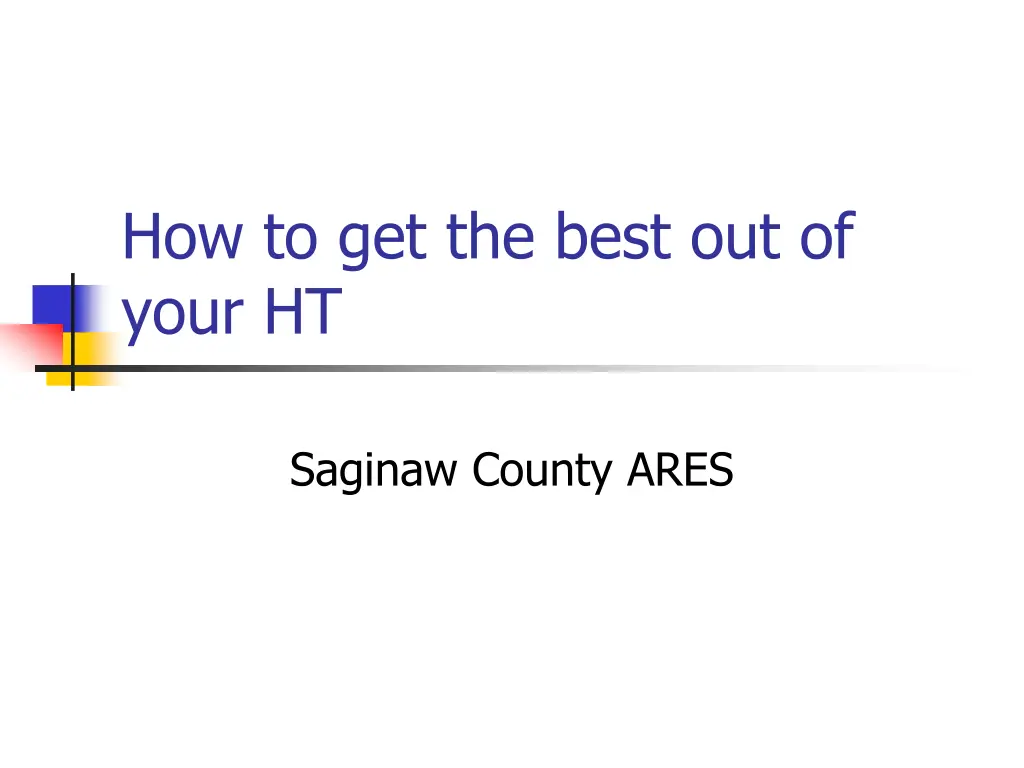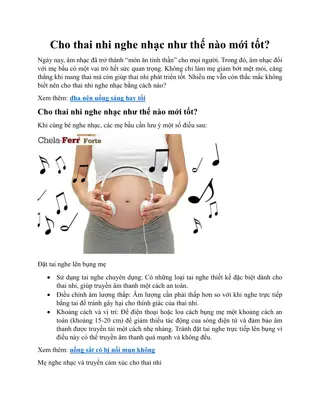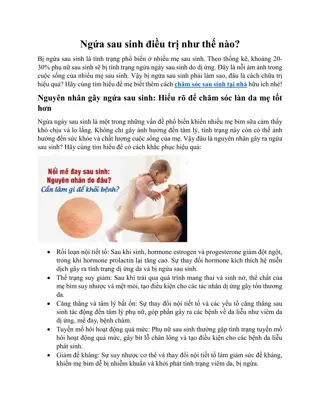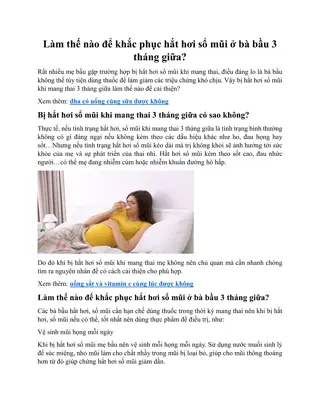
Optimizing Handheld Radios for Enhanced Signal Performance
Learn how to maximize the performance of your handheld radio in Saginaw County ARES. Discover tips on holding and using your HT effectively, getting the best signal quality, and improving communication range. Say goodbye to fuzzy signals and ensure clear transmissions with these expert techniques.
Download Presentation

Please find below an Image/Link to download the presentation.
The content on the website is provided AS IS for your information and personal use only. It may not be sold, licensed, or shared on other websites without obtaining consent from the author. If you encounter any issues during the download, it is possible that the publisher has removed the file from their server.
You are allowed to download the files provided on this website for personal or commercial use, subject to the condition that they are used lawfully. All files are the property of their respective owners.
The content on the website is provided AS IS for your information and personal use only. It may not be sold, licensed, or shared on other websites without obtaining consent from the author.
E N D
Presentation Transcript
How to get the best out of your HT Saginaw County ARES
Getting the best from our HT We ve all done it. Standing on our tippy toes. The dance, slowly swiveling around, alternating holding our arms up in the air and hands close to our ears. I m talking about the weird contortions we do until we get the best signal out of our handheld radio.
Getting the best from our HT HTs bring the promise of portable communications, but their low power makes their range limited. Repeater systems extend their range, but even the best repeaters won t help you if you are located in a bad spot. How can we make the most out of our handhelds?
Get the radio off your belt The key to getting a better signal out of your HT is in how you hold it. Handheld radios are built for portability, so everything about them is a compromise. They ve got low transmit power The antennas are small The microphone may not have the best quality So how hold and use the radio can make all the difference in how well it transmits.
Get the radio off your belt The first step in getting a better signal is to get the radio off your belt. The speaker mic was designed for the convenience of not having to hold the radio when you transmit. But your body does a lot to absorb the signal. A transceiver located next you, especially with an antenna pressed against your body is operating at a big disadvantage. If you are outdoors and in good range of the repeater, you may have no problem being heard. But move indoors and the waist mounted radio is all but useless.
Hold it right Getting a good signal out of your radio is all about holding it right. The best method is to hold the unit upright with the antenna away from your face. Speak clearly and distinctly with the microphone about 3-6 inches away from your mouth. The closer the mic is to your mouth, the better the sound pickup, especially in loud environments. I ve seen people hold their radio horizontally with the microphone all but covered up by their hand. Not only does the covered mic muffle the sound, but with the antenna in a horizontal position, your radiated signal becomes horizontally polarized. A good repeater may be able to pick up this signal, but move to a compromised location and all the repeater will receive is a muffled, scratchy signal.
Hold it right Swivel your body to find the best quality signal. Your position makes a difference, if you are receiving a scratchy signal, try moving or turning while listening and watching the S-meter on your display. You ll soon find that sweet spot. If moving doesn t work, use your speaker mic while holding the radio high in the air. Getting that antenna up above your head can make a big difference.
Expecting magic from your HT Handheld transceivers (HTs) are awesome! They pack so much radio into such a small device. Typically 2m/70cm transmit Wideband receive Memories Scanning CTCSS, DTMF tones Built-in battery Rubber duck antenna. No doubt an HT is handy, but it is a pipsqueak of a radio 5 watts output power and a compromised antenna. By itself, such a radio is limited in range to a few miles depending on local terrain. They really shine when operating through a repeater or from a high elevation.
Expecting magic from your HT Maybe it s because we are all used to good cellphone coverage that we expect the same thing from our handheld radios. A key difference is that Verizon, AT&T and Sprint have tons of cellphone towers spread across the region which provide that good coverage. Ham radio has quite a few repeaters available to us but not densely spaced. So don t expect the HT to hit every repeater in your state it won t. What to do? Be aware of the repeaters that provide the best coverage for where you are located and use them. Upgrade the antenna on your HT. If you are operating inside a car, use an external antenna on the roof.
Programming the Radio Programming the radio incorrectly is another issue. The typical amateur radio is loaded with features. The capabilities of these radios are amazing but they add additional complexity to the radio. Typically, a new Technician is focused on getting a VHF or UHF radio programmed up for use on the local repeaters. Remember FOT (Frequency, Offset and Tone) all have to be set properly to access a repeater.
Programming the Radio You ll probably want to load up the memory channels with a bunch of local repeater and simplex frequencies. The best way to do this is to use the software and programming cable for the radio. Sometimes these are included with the rig, sometimes they are optional and have to be purchased separately. If you can find someone in your area that has the same model of radio, ask them for their programming file. It can save a lot of time and effort.
Accessories ANTENNAS Most HT s come with a little 3 inch antenna. They are nice because it doesn t poke you when you wear the radio on your hip. But these small antennas are nothing but dummy loads. They often will have either 0 or a negative gain. The designers know that you ll be using the handheld with a repeater, so they figure convenience trumps utility. To increase your range, consider an aftermarket antenna. I ll switch to a higher gain antenna if I know I ll be in a situation that requires more signal. Many brands and styles are available. Most of them also claim outrageous gain figures. I d take those numbers with a grain of salt. But none the less, most any aftermarket antenna will outperform the one that came with your radio.
Accessories For even more range, an externally mounted antenna may be required. 2-meter J-Pole antenna, mast and cable. Roll-up antenna Single band dual band? Others?
Selecting an antenna https://www.youtube.com/watch?v=X1P-ZPiSNgE antenna-screenshot.jpg
Accessories BATTERIES Your battery makes a big difference in getting that signal out. A fresh battery is a good battery. As batteries discharge, their voltage drops. Modern HTs can work with a wide range a voltages, but many units will lower the transmit power as the voltage drops. Fresh, high capacity batteries will keep you transmitting a full for a longer period. Keep a spare battery in your pocket. If another station or net control can t copy you, try changing the battery. Alkaline Battery Pack Other sources of power
Getting on the air Some new hams get their license, buy a radio, stuff it into the closet and never get on the air. Big mistake. One reason is that they got into ham radio for use in case of a major calamity. When the stuff hits the fan, I ll get the radio out. Of course, that will be too late you ll be sitting there reading the manual trying to figure out how to contact someone. You really need to get familiar with the radio well before a disaster happens. Another reason new hams don t get on the air is that its overwhelming. Where do I start? Who do I talk to? Good questions. You might start by talking with a local ham you know. Ask them to get on a quiet simplex frequency and just chat with you. It s just a safe way to get some air time.
Getting on the air One challenge we have is that many repeaters are pretty darn quiet. It is common to not have anyone listening and not much chatter on a repeater. Sometimes the local repeaters sit there all day long without anyone talking on it. So if you just get on the repeater and say your call sign, you might not get a reply. Don t take it personally. What can you do? Well, listen a lot. Put your radio on scan and try to find frequencies that have activity. Find out when the local nets are scheduled and listen then. When you feel comfortable, go ahead and check into the net. When you do find a repeater or simplex frequency that seems active, go ahead and make a call. Don t be afraid to say This is KF0XYZ looking for a signal report. Anyone around? You are more likely to get a response if you make a specific request.
Not listening enough Dial around on the bands and listen to what s going on. Try to figure out who the best radio operators are and follow their example. You can learn a lot about operating procedures just by listening. On VHF/UHF, find some of your local nets and listen in. (Just do an internet search for ham radio net your city name .) Nets are a scheduled on the air meeting with a wide variety of purposes, everything from public service to technical discussions. You don t have to check into the net, just give it a listen and see what you can learn.
Conclusion Getting the most out of your handheld radio can be best summed up with the words: Location, location, location. If you are in a bad spot, move to higher ground or away from obstructions. If you are inside, get near the window. Move the radio away from your face and hold the antenna upright. Finally, get an external antenna to improve your signal.
Acknowledgements Getting a better signal out of your handheld radio by Michael Martens KB9VBR Five Common Mistakes New Hams Make by Bob K0NR How to pick the best HT antenna by K6ARK






















